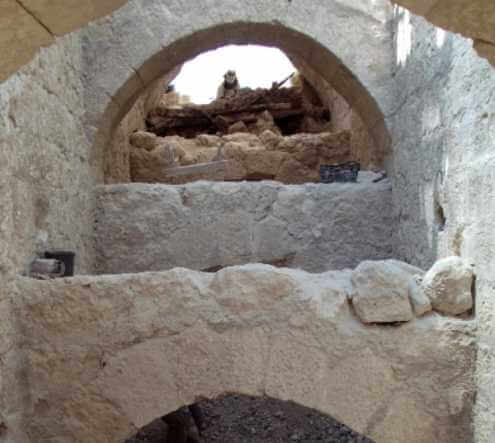At the center of the entrance array, an impressive vestibule was revealed, with a branching system of arches, which were built across the vestibule on three levels, to support its side walls and allow the passage of the king and his associates directly into the palace courtyard.

The entrance layout was revealed during archaeological excavations conducted last year in the Herodion National Park, by the Ehud Netzer excavation delegation of the Institute of Archeology at the Hebrew University, as part of the site's tourism development project. At the center of the entrance array, an impressive vestibule was revealed, with a branching system of arches, which were built across the vestibule on three levels, to support its side walls and allow the passage of the king and his associates directly into the palace courtyard.
The corridor (about 20 m long and about 6 m wide) was preserved to a height of about 20 m (!) thanks to the supporting arches, and it was built for the evaluation of the site's excavators, archaeologists Roy Porat, Yaakov Kalman and Rachel Chachi from the Hebrew University , with the beginning of the implementation of the plan devised by Herod for the transformation of Mount Herodion into an artificial mountain in the form of a volcano, which will be a prominent and impressive commemorative monument to the work of the builder king. However, during the excavations it surprisingly turned out that the 'corridor of the arches' was never actually used, and even before it was completed it was canceled and covered. It seems that this was when Herod realized that his day was near, and decided to turn the entire mountain into a 'burial mound' - a kind of giant tombstone ('nefesh') in his memory. In any case, the entrance vestibule was completely covered during the construction of the artificial mountain at the end of Herod's time, and on top of it was probably built the upper part of a new monumental staircase, which was built during this project from the bottom of the mountain to the top.
The excavators point out that not only the 'Corridor of the Arches' was covered during the construction of the artificial mountain, but also the other buildings erected earlier by Herod on the slopes of the mountain, including the Royal Theater (which was uncovered in 2008 by the expedition led by the late Prof. Ehud Netzer). The only structure on the slope that was not covered was the magnificent structure (of the mausoleum type), which was identified by Prof. Netzer and his delegation as the king's burial place, and this was, together with the cone-like mountain and the prominent structure on top of it, the focus of the unique burial and commemoration complex that the builder king established for himself .
During the recent excavations, the original entrance room of the palace was also revealed, decorated with colorful wall paintings (fresco), and an impressive entrance opening that led to it (and which was closed when the arched vestibule was abolished). In this room were found many remains of the rebels who operated in Herodion during the Great Revolt (66-71 CE), including rebellion coins and poor walls. Moreover, in the excavations inside the vestibule of the arches, impressive remains of tunnels from the days of the Bar Kochba rebellion (132 - 135/6 CE) were found, which were built in Herodion as part of the guerrilla warfare waged by the rebels against the Romans. The tunnels uncovered here, some of which were found supported and rooted in wooden beams, came out of the mountain fortress, broke through the walls of the vestibule, and led to hatches hidden in the slope. In one of the tunnels, the support structure made of cypress wood beams has been preserved intact, and includes about 20 horizontal beams placed on top of vertical beams.
The Rodion development project has partners: the Nature and Parks Authority, the Heritage and Commemoration Division of the Prime Minister's Office, the Government Tourism Society, the Antiquities Authority, the Gush Etzion Regional Council and the Civil Administration. According to Shaul Goldstein, Director General of the Nature and Parks Authority, the excavations in the 'Corridor of the Arches' are intended to allow the general public to enter through it directly into the courtyard of the mountain fortress-palace, as King Herod entered about two thousand years earlier; and to allow visitors continuous passage on top of the ancient staircase, from the buildings on the slope, including the royal theater and Herod's tomb - to the palace-mountain fortress.
More of the topic in Hayadan:
